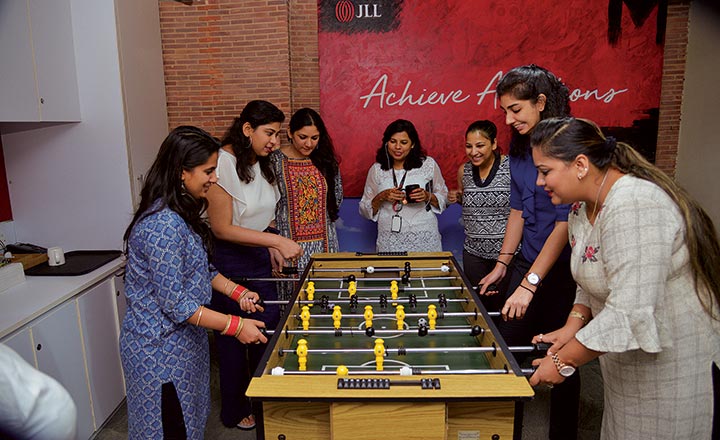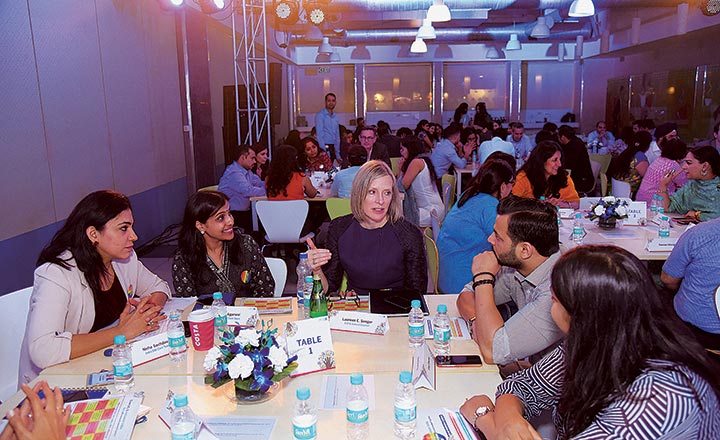In 2015, Urvi Aradhya, chief human resource officer at Inorbit Malls was having a routine conversation with Rhea (name changed), a mid-managerial employee in the architecture department, who was in her third month of pregnancy. At the time, most expectant mothers were dropping out of the workforce and the company wanted to know if they could prevent this.
During the course of their conversation, Rhea raised multiple issues. “Travelling by train and long hours at work was causing her feet to swell up,” notes Aradhya. In addition, Rhea was concerned about being disconnected from work during her maternity leave, and was also worried about taking care of her baby on resuming work. Evidently, these concerns were shared by most women.
Back then, the company had a few unstructured practices to support women. But after these conversations, it decided to have comprehensive and well-communicated policies to reassure expectant mothers, and formulated two key ones — Aanchal and Saheli.
While Aanchal provides additional transport allowance and flexible working hours, Saheli ensures that a woman employee on a maternity break is kept abreast of developments at work. The company also opened a crèche before it became the enforced norm under the Maternity Benefit Act, 1961 in 2017. “From thereon, we put together various policies and programmes ranging from training and leadership programmes to grievance redressal mechanisms and child care support,” says Aradhya.
Interestingly, Inorbit Malls is not the only one adopting women-friendly policies. Over the past few years, companies across industries — be it financial giants such as American Express and PayPal India or software majors such as Pegasystems and SAP Labs — have been investing in them.
Statistics indicate that they have made a prudent move. According to the latest data provided by the World Bank, merely 27% of working-age women were employed in 2016, against a whopping 79% among men. Further, in World Economic Forum’s Global Gender Gap Report (2017), India slid from rank 87 to 108, among 144 countries listed. Addressing this gnawing disparity is crucial not just for social justice, but also for economic growth.
Fortunately, attempts at diversity and inclusion are becoming more frequent. Leading the way are 15 companies, who have been chosen as India’s Best Workplaces for Women by global firm Great Place to Work. Over 600 Indian organisations had applied, making it the largest study on workplace recognition. Hopefully, these companies will inspire many others.
Inclusiveness matters
Col John Chenetra, president, SecUR Credentials, says that women have traditionally been assigned jobs lower down the ladder. These included desk jobs involving coordination, customer-facing client servicing jobs or clerical work. “The change started around 1995, when women started to become as qualified as men. They graduated from engineering and management colleges and were employed in varied industries such as software, BPOs, human resource and finance,” he says. Opportunities in sectors such as administration, banking, NBFC, marketing and sales, etc. also opened up gradually.
There was better gender diversity at workplaces and it was good for the bottomline. In a 2017 survey, Deloitte found that organisations with diverse and inclusive cultures tend to be 6x more innovative, 6x more agile in anticipating and responding to change, and 2x as likely to meet or exceed financial targets. Studies also suggest that women have an upper hand in terms of empathy, communication skills, patience, understanding consumer markets and households, systematic process orientation and public relations skills. Chenetra says that the ability to multitask makes women effective team managers. Jayanthi Vaidyanathan, senior director and head HR, PayPal India, concurs, and adds, “Data tells us that women tend to be more perceptive. Hence, adding such voices to senior-level conversations unlocks diverse thought processes and approaches to problems.”

Kaushik Chakraborty, director, human resources and CSR, JLL India, adds that on any given day, a gender-diverse workforce is more profitable. Despite operating in the real estate sector, which is believed to employ more men, JLL has women holding key positions. In Vietnam, the company has a higher percentage of women employees. “Our global chief human resource officer, global finance head and global chairperson are all women,” he says. “If you are going to pitch for a big account anywhere in the world today, and if your team is only five men in black suits, the likelihood of you losing that deal is almost 100%,” he asserts.
Yet, Indra Nooyi, CEO, PepsiCo, famously said, “The biological clock and the career clock are in total conflict with each other.” And she had summed up what most women feel. Many drop out in the mid-managerial level. “The bottom pile has many women from colleges, especially in technology companies like ours. They get placed from campuses like men. But their numbers start to dwindle in the first, second and top-line management layers,” rues Shanthi Sundar, senior director and head of human resources in India at Pegasystems. She believes that women are not confident that they can balance their career and personal life and consider themselves as the family’s secondary breadwinner.
Internal studies done over the past couple of years at Pegasystems reveal that even if women are eligible for promotion, they think twice before accepting it because they need to be ‘100% ready’ for it. In contrast, men will accept the promotion even if they are just 60% ready, since they feel they can learn on the go.
Hiring spree
Recognising the drawbacks women face, companies are beginning to carve out unique policies for women. These include focused hiring of women, informative sessions on health and nutrition, flexible work hours and provisions for childcare. As Annette Dixon, vice president, human development, World Bank, said in a 2018 speech, “Employers need to walk the talk and commit to supporting diversity in the workplace by hiring women and paying them the same wages as men for similar jobs. We need safe transportation and zero tolerance of sexual harassment in the office.”

Pegasystems has started setting targets in hiring women for every department. “When I joined Pega about three-and-a-half years ago, we had 19-20% women in the workforce,” says Sundar. Today, after setting out to change it, the number has gone up to 30%. GE Appliances (a Haier company), too, stresses on roping in more female students from college campuses. Meanwhile, programmes such as PayPal CAN tries to encourage the young workforce to work closely with the leadership team, take initiatives and run the organisation.
Pegasystems has also devised a unique hiring mechanism. A group of women called Ambassadors for Pega speak to possible hires about the work environment, culture and experience. As a result, nearly no one rejects an offer, says Sundar. Also, when the company hires women, they don’t simply offer hikes by industry standards. Instead, they look at their skill-set and what employees in that scale are paid in their organisation and then offer a raise, even if it means a 100% increase.
In organisations such as SEWA Rural, senior leadership roles always had a high percentage of women since its inception four decades ago. “Our flexible approach in terms of timing and leave, proximity to the place of residence and other support structure have resulted in female employees taking up higher responsibilities,” says Gayatri Desai, gynaecologist and trustee at the company. Their staff is 46.4% female.
Maternity concerns
Hiring more women, however, is only the beginning. The company also addresses their concerns, a majority of which are around maternity. Company reports and independent surveys suggest that attrition rate is the highest among women during this phase and companies are trying hard to counter this.
For instance, at PayPal India, expectant mothers in their third trimester are entitled to cab fares to and from office. A gynaecologist also visits the office twice a month and the period of maternity leave has been extended for six months, a policy which was in place before the law mandated it. In addition to similar policies, Inorbit Malls has introduced an adoption assistance policy, under which financial aid is given to offset legal costs and paid leave is given to adoptive parents.
However, returning to work post childbirth is tough for most women. Either they never return or they come back with the guilt of neglecting their family and child. Plus, resuming work after a prolonged absence becomes a struggle. To make this transition smooth, Chakraborty says that the company holds a welcome ceremony for the employee, in which her colleagues and senior leadership participate. “We realised the need for such a programme through the conversations that women employees had with our ‘mavens’,” says Chakraborty. Mavens are senior women executives that an employee can approach if she doesn’t feel free speaking to the HR head or the manager.
At Tata Communications, Aadesh Goyal, chief human resources officer, encountered a similar problem. About five years ago, the company formed a group of all their women employees on an online portal and asked them to share common challenges. “A frequent answer was that a long family care leave usually pulls down their performance rating. We immediately took a decision barring the manager from reducing the rating of anyone who has been on leave for six months or more,” says Goyal.
He adds that it is all about observing a problem and addressing it in the best possible way. About four years ago, he says, they noticed that leaders of small teams hesitate to recruit many women because if two to three women go on family or maternity leave at the same time, then the work suffers. And they didn’t have the budget to hire temporary replacements. “From then on, we made it a policy that when an employee goes on a long paid leave, we will pay for hiring a replacement for that person from the corporate budget,” he says.
These companies also provide women the option of a phased re-entry into full-time employment. At GE Appliances, women can work part-time for the first month post the maternity leave at the same pay. “This allows them to successfully transition into work,” says Preet Boparai, senior HR manager, GE Appliances. The company also offers women the option of working from home, if required.
Women may be keen on returning, but there are often not enough opportunities available. Vaidyanathan says that while 40% women drop out six to eight years into their career, 90% want to come back. PayPal India runs a programme, called Recharge, which helps people who want to return to work to expand their experience and network. In the past three years, 22 women have been hired by the company through this. Similar initiatives are also run by Intuit, Tata Communications and American Express by the name of Intuit Again, Second Career and ReNew respectively.
To make the rejoining easier, organisations now offer day care facilities on or near campuses. Take, for instance, Hyderabad-based education services provider People Combine. “Till last year, we had daycare centres on five campuses and now we have extended it to 12 out of 15,” says Rajeev Tupsakri, chief people officer. For the remaining three, the daycare centres are located within 5 km. PayPal India and software firm Intuit have also started offering these services.

Providing support
Besides providing help with rejoining, companies also hold workshops to hone their leadership skills. There are also frequent interactive sessions with senior management, including ‘speed mentoring’ where they shadow leaders, and women are encouraged to share their problems and inputs on new policies. An interesting example is GE Appliances’ Learn n Lead, through which employees get short-term experience of a week or a month in anything outside their current area of work.
Support is also given to women who have to move cities or even countries when their spouse is transferred. GE Appliances allows its female employees to continue working from their new country of residence. Sundar says that they, too, have extended this option to a few women employees.
Thanks to such policies, companies have seen a significant drop in attrition rates and an improvement in their gender diversity. At Pegasystems, the attrition rate for women has been around 9-10% for the past three years, while the same has been 14% for men. Vaidyanathan says, “While I can’t share specific numbers for PayPal India, the number of women in senior management has grown considerably. We have also been able to attract women at the mid-managerial level. For example, in 2017, we saw the number of promotions for women in India double.” Jayashree Sundaresan, director, global operations, PayPal, says, “This change in the right direction in the last few decades would not have been possible without many organisations doing many things right.”
Promoting equality
Organisations may have hit the right track, but they have to ensure that these policies don’t come across as a ‘favour’. “Women who opt for flexible work hours or work from home should not feel that they are taking undue ‘advantage’. These need to be normalised,” says Vaidyanathan. The quality of talent hired should also not be compromised, lest it is seen as mere tokenism.
This can be done through constant communication and engagement with, not just women, but also male employees. “In our company, men are also a part of the Mavens group,” says Chakraborty. “Also, earlier, invites to webinars on health and leadership would go out only to women employees. But we realised that men need to be a part of these too, to increase awareness and sensitivity. We have expanded our agenda to foster gender, geography and generation inclusion,” he says.
Verna Myers, founder and president of the eponymous Consulting Group, explained it best when she said at a TED talk two years ago that, “Diversity is about being invited to the party, and inclusion is being asked to dance.” “Five years ago, it was probably just an invitation to the party. Today, everybody is dancing together,” says Chakraborty.
Goyal adds that they are pushing for a culture where family care is seen as a responsibility for both men and women. “So two years ago, even before the maternity policy came in, we introduced a global childcare/family care leave. Men or women can take six months’ paid leave irrespective of the local law.”
The Nav Dampati Mela, organised at SEWA Rural, also has a similar objective. Sessions for newly married employees are organised on various aspects of married life such as saving, planning, childcare, etc. and they lean towards the needs of female employees or male employees’ spouse.
Additionally, for the success of these policies, all departments need to come together and ensure thorough implementation. At GE Appliances, diversity and inclusion are taken care of by employees and is not a function of human resources. Leaders participate in various ways, for instance, by sharing their experience and time. Tata Communications, too, organises workshops on the unconscious bias.
Goyal explains this bias with an example — a situation where in a manager and his team members arrange a meeting and they decide on an informal brainstorming session at around 7 p.m. at the bar. “Now, the manager may have meant well by encouraging an open discussion. But, ‘7 p.m. at a bar’ creates a bias against an employee who needs to be at home for the family. Or one who doesn’t go to a bar for personal or religious reasons,” he says.
JLL, meanwhile, celebrates diversity and inclusion week annually with panel discussions, speed networking sessions, games, gender sensitivity workshops and theatre-based subconscious bias workshops. The future, thus, looks vibrant, with men and women working together to build an inclusive workspace. As more and more companies join in the effort, the journey will only get more interesting, and hopefully, more inclusive.











